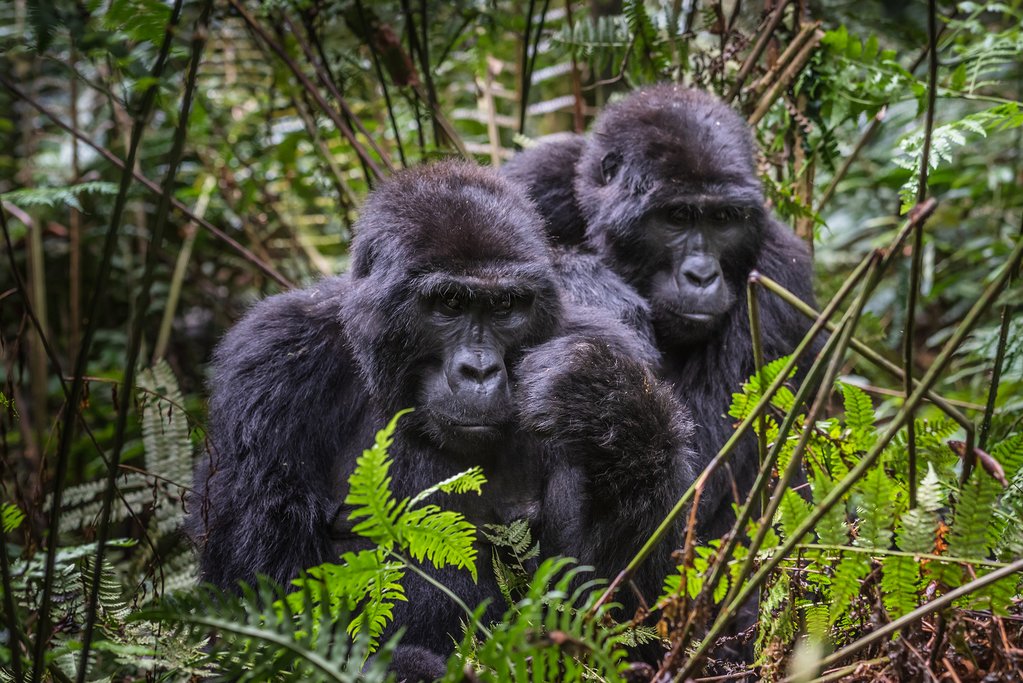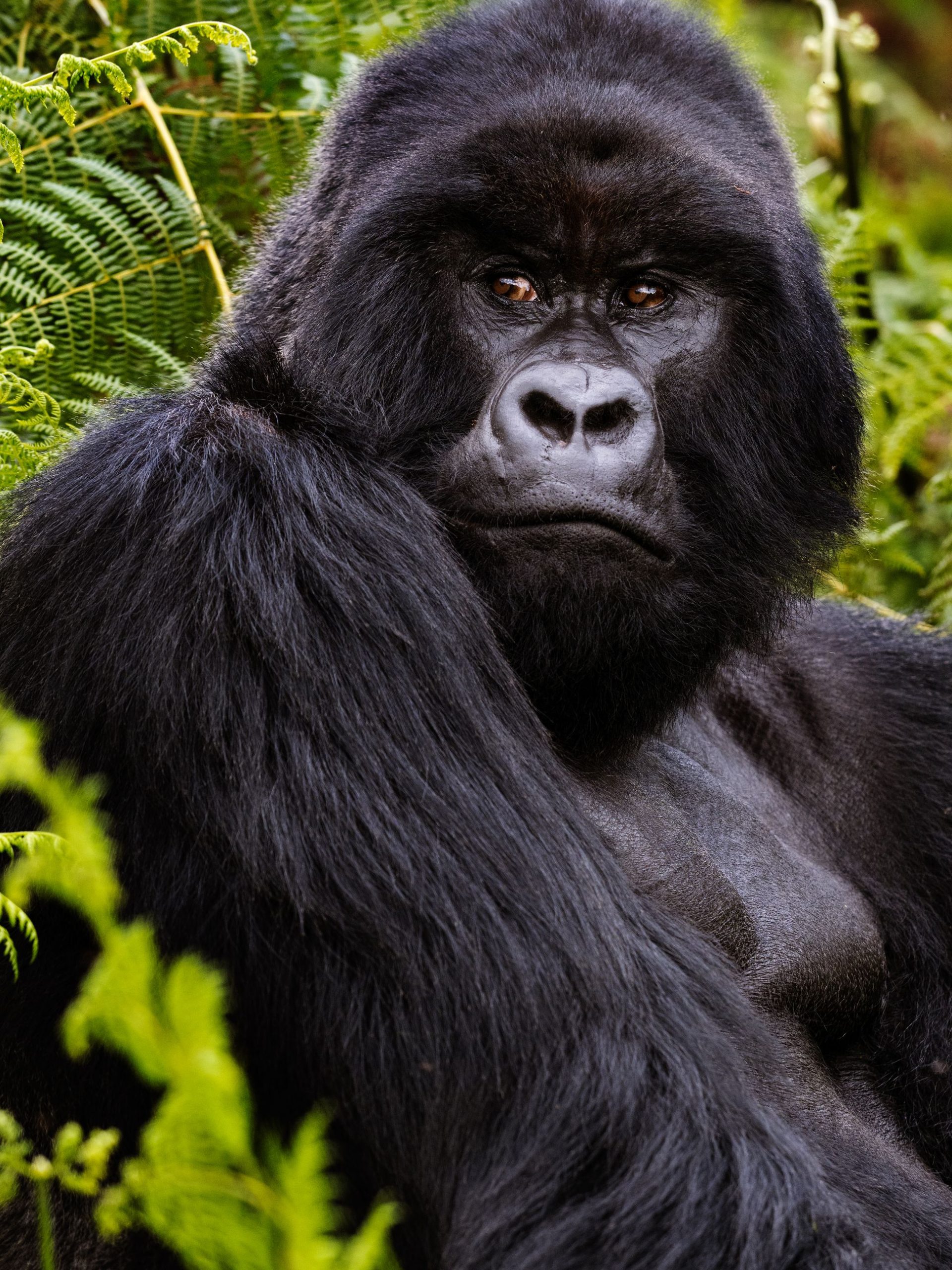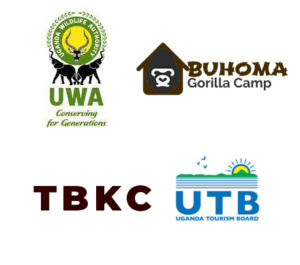
Bwindi impenetrable national park is located in southwestern Uganda, a UNESCO world heritage site and one of the most biologically diverse areas on earth.
It is renowned for its exceptional biodiversity harboring a rich variety of flora and fauna, its home to approximately half of the world’s endangered mountain gorilla population making it a crucial conservation area.
The park is a prime destination for gorilla trekking, visitors get chance to embark on guided hikes through the dense and lush forest to encounter habituated mountain gorilla families. This unique and intimate experience contributes to gorilla conservation efforts.
Bwindi is divided into different sectors, each hosting distinct gorilla families. These families have been habituated to human presence, allowing for safe and regulated interactions during treks. It is also paradise for bird enthusiast, boasting over 350 bird species including several endemic ones. The diverse avian population adds to the allure of Bwindi.Bwindi’s varied elevations support a mosaic of eco systems from montane forest to bamboo zones. The park is also home to various primates such as chimpanzees and monkeys as well as diverse plant life.
Apart from gorillas, Bwindi shelters various other primate species including chimpanzees and various monkeys. The forest is also home to over 350 birds making it a paradise for bird watchers. The diverse eco system encompasses waterfalls, rivers and diverse flora contributing to its status as one of Africa’s most biologically rich areas.Other primates found in the park are various monkey species including L’Hoest monkey, blue monkeys, red tailed monkey and black and white colobus monkeys. Notable birds in the park includes African green broadbill, Shelley’s crimson wing and the handsome francolin.
Apart from primates, Bwindi is home to various mammal species such as forest elephants, bush bucks, duikers and several bat species. The forest also hosts diverse amphibians and reptile species, adding to its ecological complexity.
About Bwindi Impenetrable National Park
- `Mountain gorillas.
The highlight of Bwindi is undoubtedly the chance to see mountain gorillas. Gorilla trekking provides a unique opportunity to observe these incredible creatures in their natural habitat.
- Gorilla families.
Bwindi is home to several gorilla families, each with its own dynamics and individuals. Visitors may encounter different families during their trek, each offering distinct experience.
- Golden monkeys.
Besides gorillas, Bwindi is known for its population of endangered golden monkeys. Watching these playful primates add another layer to biodiversity of the park.
- Bird watching.
Bwindi is a paradise for bird enthusiast, with over 350 bird species including rare and endemic ones. The African green broadbill, Shelley’s crimson wing, and various turaco species are among the avian highlights.
- Waterfalls and rivers.
Discover scenic waterfalls and meandering rivers within the park. These natural features add to the overall beauty of the landscape.
- Primate species.
In addition to gorillas and golden monkeys, Bwindi is home to various primate species such as chimpanzees, blue monkeys and black and white colobus monkeys.
- Flora and plant life.
Bwindi’s varied elevations support a diverse range of plant life including rare orchids, ferns and towering trees. The forest itself is an immersive experience for those interested in botanical wonders.
- Scenic landscapes.
the mist covered hills, deep valleys and lush vegetation create a stunning backdrop for exploration. The diverse landscapes contribute to the park’s designation as an impenetrable forest.
- Cultural encounters.
Some tours offer cultural experiences with the Batwa people. The indigenous inhabitants of the region. This provides insights into their traditional practices, music and dance.
In Bwindi national park, you can engage in a variety of activities to cater to different interests.
- Gorilla trekking.
The main attraction in Bwindi is gorilla trekking, offering a once in a life time opportunity to encounter mountain gorillas in their natural habitat. The experience is regulated and guided, ensuring the well-being of both visitors and gorillas.
- Golden monkey tracking.
Explore the forest to track and observe the endangered golden monkeys known for their vibrant colors and playful behaviors.
- Bird watching.
Bwindi is a haven for bird enthusiast. Join guided birdwatching tours to spot a wide array of bird species including various turacos, crimson wings and African green broadbill.
- Gorilla habituation.
Visitors are given chance to habituate gorillas, this process makes wild gorillas get adapted to human life as a way of preparing them to be trekked.
- Batwa trail.
participate in the Batwa trail, guided experience led by Batwa guides. This trail provides insights into the traditional practices, skills and knowledge of these people.
- Cave exploration.
Explore the Nyakabare cave near Buhoma. This limestone cave offers an intriguing underground experience, providing a different perspective of the park.
- Forest canopy walkway.
Experience the forest rom a different vantage point by walking on the canopy walk way. This elevated walk provides panoramic views of the forest and its inhabitants.
Our Partners
Uganda Tourism Board
.
Uganda Wildlife Authority
.
The Buhoma Gorilla Camp
.
The Bwindi Kids Charity
.
What our customers Say ?
ExcellentBased on 21 reviews
 Headspun2023-07-16Unforgettable Rwanda Emerald tailored our 5 day trip to Rwanda to all our many and frequently changing requests without any fuss. Chris, our driver/guide for the duration, could not have been more helpful and professional
Headspun2023-07-16Unforgettable Rwanda Emerald tailored our 5 day trip to Rwanda to all our many and frequently changing requests without any fuss. Chris, our driver/guide for the duration, could not have been more helpful and professional Nic2022-10-25Amazing holidays! Great holidays! Even my special wishes were included into the planning although time was short. Our guide and driver City Tyson Magezi was caring and responsible. We traveled for four weeks and stayed in different accommodations from hut to tent to amazing hotels.
Nic2022-10-25Amazing holidays! Great holidays! Even my special wishes were included into the planning although time was short. Our guide and driver City Tyson Magezi was caring and responsible. We traveled for four weeks and stayed in different accommodations from hut to tent to amazing hotels. Susanne2022-08-19Just amazing It felt so safe and comfortable and exciting to travel with emerald. Our guide was so caring, so experienced and always friendly and an a great mood. He showed us so many animals included lions and leopards. That was just amazing . We saw wonderful landscapes like waterfalls and had contact to people . No Uganda or Eastern Africa without emerald . I m deep in love with Uganda and will come back as soon as possible.
Susanne2022-08-19Just amazing It felt so safe and comfortable and exciting to travel with emerald. Our guide was so caring, so experienced and always friendly and an a great mood. He showed us so many animals included lions and leopards. That was just amazing . We saw wonderful landscapes like waterfalls and had contact to people . No Uganda or Eastern Africa without emerald . I m deep in love with Uganda and will come back as soon as possible. Jose Murta2022-05-13Memorable Family Trip in Uganda Fantastic Trip that exceeded our expectations! Travelled to Uganda with wife and 2 children (9 and 10y old) for 7 days. Since the start (at planning stage) got a great support from Bob (company owner) and Edmund (our guide) via WhatsApp. They tailored a program to our needs including the unforgettable mountain gorillas hike, general hikes to waterfalls, safari including boat trip to see hipos!! Edmund, our guide, always super polite and the kids enjoyed him a lot! All our hotels, meals included in the package so no hassle on this….we just paid for drinks! The only regret I have is not staying one extra day in the Mburo National Park to explore a bit more ;) Memorable trip with so much nature and a super-humble people that made the experience even more enjoyable!! Super recommend!! The whole family just feeling we need to get back to explore more ;)
Jose Murta2022-05-13Memorable Family Trip in Uganda Fantastic Trip that exceeded our expectations! Travelled to Uganda with wife and 2 children (9 and 10y old) for 7 days. Since the start (at planning stage) got a great support from Bob (company owner) and Edmund (our guide) via WhatsApp. They tailored a program to our needs including the unforgettable mountain gorillas hike, general hikes to waterfalls, safari including boat trip to see hipos!! Edmund, our guide, always super polite and the kids enjoyed him a lot! All our hotels, meals included in the package so no hassle on this….we just paid for drinks! The only regret I have is not staying one extra day in the Mburo National Park to explore a bit more ;) Memorable trip with so much nature and a super-humble people that made the experience even more enjoyable!! Super recommend!! The whole family just feeling we need to get back to explore more ;) Dwayne B2022-05-13Great Experience With Emerald!! It was an amazing experience! My guides Lucky and Hillary made me feel as if I was family and took care of everything I needed. They were very knowledgeable as we trekked to gorillas in Bwindi and a ride a wildlife safari through Queen Elizabeth. I learned so much from them about the animals, the terrain and the surrounding people. They we also incredibly helpful in helping me find activities around Buhoma, where I stayed, all of which were great. By the time I left I knew I had made friends who I will continue to stay in touch with. Can’t wait to come back with my family!
Dwayne B2022-05-13Great Experience With Emerald!! It was an amazing experience! My guides Lucky and Hillary made me feel as if I was family and took care of everything I needed. They were very knowledgeable as we trekked to gorillas in Bwindi and a ride a wildlife safari through Queen Elizabeth. I learned so much from them about the animals, the terrain and the surrounding people. They we also incredibly helpful in helping me find activities around Buhoma, where I stayed, all of which were great. By the time I left I knew I had made friends who I will continue to stay in touch with. Can’t wait to come back with my family! Dávid B2022-05-12Feeding python - 9 lions on a tree - leopard vs. lion We saw all animals and extremely special situations in a short period of time, good organization and friendly guide Paul with lots of knowledge.
Dávid B2022-05-12Feeding python - 9 lions on a tree - leopard vs. lion We saw all animals and extremely special situations in a short period of time, good organization and friendly guide Paul with lots of knowledge. Rachmurta2022-05-10Unforgettable trip! We spent one week in Uganda travelling by the guidance of Gorilla Experience safari. The whole experience were definitely above our expectations. Edmand was a friendly, polite and kind guide the whole time!
Rachmurta2022-05-10Unforgettable trip! We spent one week in Uganda travelling by the guidance of Gorilla Experience safari. The whole experience were definitely above our expectations. Edmand was a friendly, polite and kind guide the whole time! Vit Siv2022-04-22Ultimately Unique Experience of Uganda! It was unbelievable unique experience, one in a life time. Everything right from arrival to minor ditals was taken care of, too service! Itinerary was compiled/tailor to our wishes and needs as well as to include as much activities as possible. Tyson was our guide. He is an amazing guide, but even better person. He did an incredible job to put this all together, and make it all happen. We managed to do everything we wanted and even more. Definitely a trip to remember!!
Vit Siv2022-04-22Ultimately Unique Experience of Uganda! It was unbelievable unique experience, one in a life time. Everything right from arrival to minor ditals was taken care of, too service! Itinerary was compiled/tailor to our wishes and needs as well as to include as much activities as possible. Tyson was our guide. He is an amazing guide, but even better person. He did an incredible job to put this all together, and make it all happen. We managed to do everything we wanted and even more. Definitely a trip to remember!! Emmanuel OKalany2022-01-08A rewarding experience for a family visit to queen Elizabeth National Park My family and I had an excellent guided tour to Queen Elizabeth National Park. The itinerary planning provided was good and the costing of items was realistic. The care and hospitality of the team was excellent. They were also flexible to make time adjustments brought about because of traveling with children
Emmanuel OKalany2022-01-08A rewarding experience for a family visit to queen Elizabeth National Park My family and I had an excellent guided tour to Queen Elizabeth National Park. The itinerary planning provided was good and the costing of items was realistic. The care and hospitality of the team was excellent. They were also flexible to make time adjustments brought about because of traveling with children Gordon Y2021-06-23Trip to Kaiso Tonya Game Reserve The guide/driver was too keen to find out my interests. That way, we always had something to talk abouts. Thank you
Gordon Y2021-06-23Trip to Kaiso Tonya Game Reserve The guide/driver was too keen to find out my interests. That way, we always had something to talk abouts. Thank you



